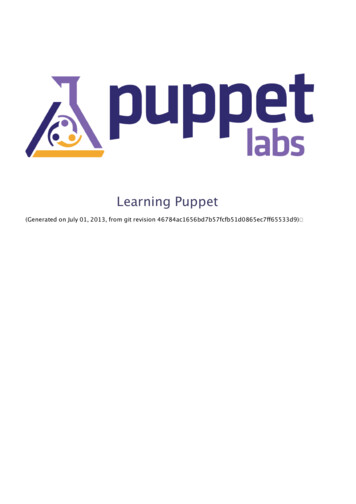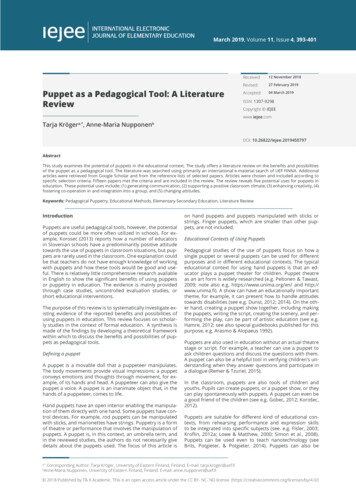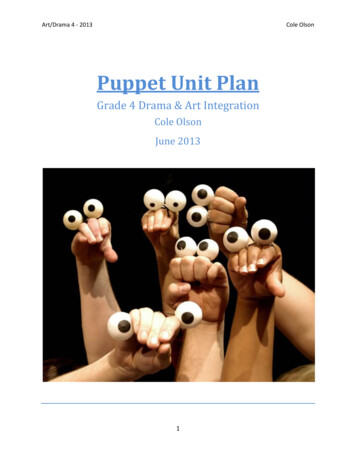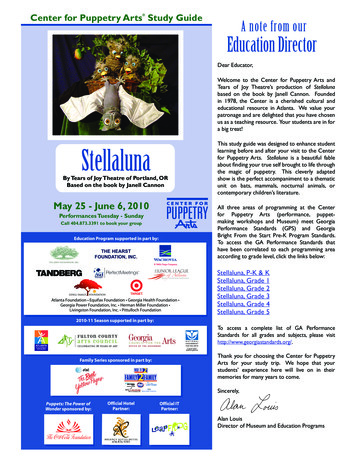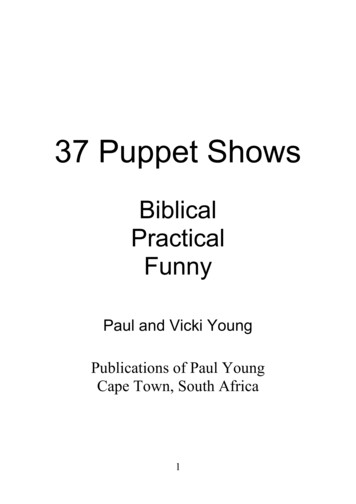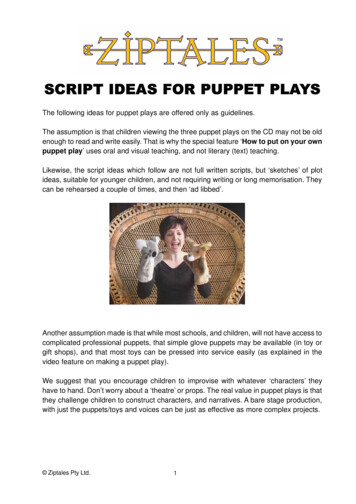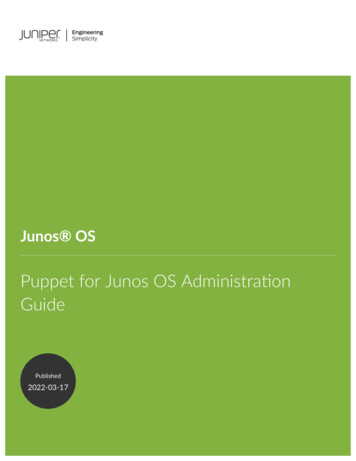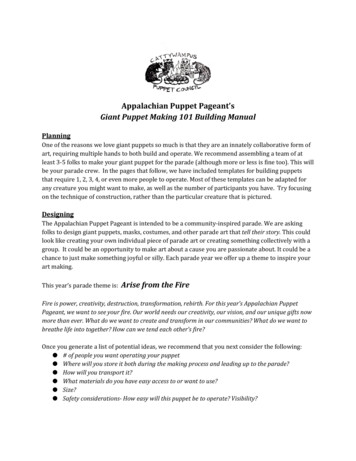
Transcription
Appalachian Puppet Pageant’sGiant Puppet Making 101 Building ManualPlanningOne of the reasons we love giant puppets so much is that they are an innately collaborative form ofart, requiring multiple hands to both build and operate. We recommend assembling a team of atleast 3-5 folks to make your giant puppet for the parade (although more or less is fine too). This willbe your parade crew. In the pages that follow, we have included templates for building puppetsthat require 1, 2, 3, 4, or even more people to operate. Most of these templates can be adapted forany creature you might want to make, as well as the number of participants you have. Try focusingon the technique of construction, rather than the particular creature that is pictured.DesigningThe Appalachian Puppet Pageant is intended to be a community-inspired parade. We are askingfolks to design giant puppets, masks, costumes, and other parade art that tell their story. This couldlook like creating your own individual piece of parade art or creating something collectively with agroup. It could be an opportunity to make art about a cause you are passionate about. It could be achance to just make something joyful or silly. Each parade year we offer up a theme to inspire yourart making.This year’s parade theme is:Arise from the FireFire is power, creativity, destruction, transformation, rebirth. For this year’s Appalachian PuppetPageant, we want to see your fire. Our world needs our creativity, our vision, and our unique gifts nowmore than ever. What do we want to create and transform in our communities? What do we want tobreathe life into together? How can we tend each other’s fire?Once you generate a list of potential ideas, we recommend that you next consider the following: # of people you want operating your puppet Where will you store it both during the making process and leading up to the parade? How will you transport it? What materials do you have easy access to or want to use? Size? Safety considerations- How easy will this puppet be to operate? Visibility?
Cardboard Armature: If you aren’t using clay to sculpt with, a cardboard armaturecan be used to build the entire shape of your puppet. You can also incorporatewadded up newspaper to “build” up certain areas. The easiest way to put acardboard armature together is to use staple pliers. Once you have this structurecomplete, you can then papier-mâché directly on top of it. If you are using clay, youcan still use a cardboard armature but will want to make sure that you build it sothat it can withstand the weight of the clay.*Heavy lines mean to cut and overlap, stapling. Dotted lines mean to score lightly and bend. Clay: If you want to make a more detailed, more fluid face or creature, sculpting ontop of your armature with clay can be a great method. Starting with slab pieces andthen adding more details is recommended. Once you are finished, you will want touse a plastic grocery or trash bag as a release layer between the clay and papiermâché. Cut your bag open so that it lays as one piece. Cover your clay sculpture withthe bag, making sure to get it into all of the nooks and crannies, so that you willretain as much detail as possible when you papier-mâché.2. Cornstarch Papier-Mâché: Making GOOP! Heat 1 gallon of water in an old pan on the stove and bring to a boil. While the water is heating, in a separate small bowl, stir in 2 cups of cornstarch with asome extra water, until it is completely dissolved. Once water is boiling, reduce heat and stir in cornstarch mixture. Once it has thickened, remove from stove and allow to cool before using. A slightlywarm mixture is pleasant to work with! For a smaller project, use 1/8 c cornstarch to 1 cup of water.
3. Paper Brown paper bags are our favorite for papier-mâché because they are stronger andheavier than newspaper. Tear the paper into 1-2 inch strips. For more or less detailed areas, you can increaseor decrease the size of your strips. One at a time, dip each strip into the goop so it will become saturated. Strip theexcess goop off with your fingers and lay the strip onto your creation, trying to get itto lay as flat and smoothly as possible. To build strength, we recommend applying 4-6 layers on a clay armature. On acardboard armature, 2-4 should be plenty. To help keep track of the layers, werecommend alternating them, print side up and print side down. After a few layers,allow your piece to dry before applying remaining layers. After you have finished your last layer, allow your piece to completely dry. You canset up a fan on your piece to accelerate this process.4. Painting/Finishing First be sure your creation is completely dry. It is now time to remove your papiermâché from your armature if you used clay during the process. If you made a 360 creation, you will need to cut off the papier-mâché using a utility knife. Once it isremoved, you can re-seam it back together using tape and then more papier-mâché.For 180 creations sculpted flat on a board or table, you should be able to gently liftthe papier-mâché off of the plastic layer. Papier-mâché can be painted with acrylic paints or latex house paint. We like to usehouse paint because we can often get used house paint for free. You can also use tissue paper instead of paint, using a white glue mix (1 part water:1 part white glue). You can use the papier-mâché method described above or lay thetissue paper on your creation and paint the glue mix on using a cheap foam brush. Other Ideas: Apply faux fur Fabric Hot glue sparkles, papier-mâché/cardboard glasses, fake hair, etc. If you are making a head to wear, you can use foam to line the inside of it, attachingit with hot glue!Rigging Methods/Design TemplatesThe following excerpts are sketches and photos from “68 Ways to Make Really Big Puppets”. Thesedesigns were put together by The Puppeteers’ Cooperative, who have inspired so many. Visittheir site http://puppetco-op.org/ for additional ideas!
Backpack Frame1 person puppetNote: A backpack puppet with an eight-foot upright takes about twelve yards of cloth for thecostume and hair.Backpack puppets are built on a pole which is attached to a backpack and worn like a regularbackpack. The advantage is that the movement is very natural; the puppet simply does everythingyou do. The disadvantage is that it takes help to put it on.Note: The easiest way to make a backpack is to buy an external frame backpack from the thriftstore and to screw or duct tape it to the upright pole.Making a homemade backpack
Putting it onAttaching HeadsBoxNote: The box is most suitable for backpack and other puppets where the head is not attached tothe costume, and you want to remove it for transport. The box should be loose enough to let thehead move, but not so loose that it can spin on the pole.
StringWoodLashing with paracord works well for attaching your bamboopole to your puppet head. We use square lashing. There areplenty of YouTube videos out there to get you started. To theleft, we included an illustration of a square lashing to get youstarted.HandsIf you have clay, you can make hands out of clay, cover it with thinplastic, and do 3-5 layers of papier-mâché with heavy paper. Youcan also use a cardboard & newspaper armature to make handsthat you then papier-mâché or try the cardboard template below.Cardboard Single HandCardboard Double Hand
Wire BirdTwo-person FishHat Cat
3 Person BirdNote: Bird takes about nine yards of light cloth. Fringe looks good on this bird.Half-hoop CaterpillerNote: A thirty-foot dragon takes four widths of cloth, or forty yards. Run seams across the width forthe ribs.Kid-King
Note: This puppet can be made with kids as young as first grade. It is simple but large andimpressive.PoseidonPoseidon CostumeNote: This puppet takes about 15 yards of cloth for the costume, hair, and decoration.
Praying MantisNote: Because the balance point of the Preying Mantis is so high up, it can rather easily be as tall as18-20 feet. The long sticks need to be good wood.MermaidNote: A thirty-foot dragon or mermaid takes three widths of cloth, or thirty yards, plus half as muchagain for fringe or decoration. Run seams across the width of the cloth for the ribs.
Other Ideas for Parade Items:
Wire-various gaugesFabric: all sorts of colors (lightweight synthetics are preferable)Old bed sheets: white and coloredRibbonPlastic zip tiesFoam (thick pieces)Corrugated cardboard single wall, large flat pieces: great for sculpting (Lots!)Corrugated cardboard double wallKraft paper (nice for final papier-mâché layer)Brown paper bagsNewspaperDuct tapeNylon twinePVC plumbing pipe, various sizes ¾ inch to 3inch diameterHeavy cardboard tubesVelcroAcrylic paintGlitter, sequins, miscellaneous fun trimmingsFaux furWhite glueCornstarchExternal frame backpacks (just the frame and harness)Bicycle helmets (good for armatures, as well as starting point for masks/head-mounted structuresClear packing tapeMasking tapeUsed bottle caps for cardboard washers (flatten with hammer and punch nail hole in center)Wood (pine, fir, or spruce): 1” x 1” x 8’, 1” x 2” x 8’, ½” x 2” x 8’Wooden dowelsScrews & nailsBamboo poles (can be harvested locally)- large diameter for main support poles, ⅜” diameter forsmaller structure pieces.Rit Dye (for dyeing fabrics)Material & Tool SourcesBamboo: Ask around. Most people who have it growing in their yard would love to get rid of someof it.Cloth & Fabric: Cloth can generally be the most expensive element of any giant puppetconstruction. Nylon, polyester, and man-made blends tend to be better than cotton as cotton isheavier, retains moisture, and is subject to sagging. The exception to this is if you are planning todye the cloth. When dying cloth, untreated muslin is the best option. We also have dyed cotton bed
sheets before. We like using Rit Dye for this. Check Jo-Ann’s for sales and take advantage of theironline coupons.Corrugated Cardboard: Pretty easy to get for FREE! Check with Walmart, Home Depot, Lowe’s,Best Buy, Furniture and mattress stores, etc. Small cardboard boxes are really easy to get but largerpieces can require a bit more hunting. Mattress stores are generally good sources for bigger sheets.Below is a diagram showing the different cardboard configurations that you will come across. Werecommend Single Wall cardboard as it is the easiest to sculpt with. Double Wall is better forcovering flats, making signs, etc.Craft and Art Supplies (Tissue, Glue, Paint, Kraft paper, Feathers, Fabric, etc.): Jo Ann’s,Michaels, A.C. Moore, Jerry’s ArtaramaFoam: We like to support the Foam Rubber & Factory Outlet (1323 N Central). You can buy foam ofany size there and sometimes they have scraps they will let you have for free as well.Paint: Ask paint stores for mis-tints. Acrylic-latex only. Bold primary colors are nice, as well asblack and white so you can mix any color you want. You can also try the Habitat Re-Store andCraigslist. You can also use regular student-grade acrylic paint.Staplers: The best staplers for puppetry construction are called Staple Pliers. They have a pointedtip that enables you to staple cloth or cardboard away from the edge by penetrating the cardboardwith the point and then stapling. The most affordable “sword point” stapler we’ve found is theSalco P694 Sword Point. Bostitch also makes a staple plier but it is light duty and not recommended.Salco staple pliers can be purchased directly from Salco: www.stapleheadquarters.comSalco P694 S/P 1 36.65, 3 33.75
*Remember to purchase staples as well. Recommended size for puppetry construction is ⅜ inch,galvanized.Wood: 1” x 2” stock works well for re-inforcing many constructions. Check local building sites asscraps are commonly thrown out and can be recycled.Thrift Stores: Local thrift stores can be a gold mine for fabrics and other random puppet makingsupplies. Check out Am Vets, Goodwill, KARM, Ladies of Charity, etc. Who knows what you’ll find?*This document was compiled by Cattywampus Puppet Council, 2017 We need your creativity andideas, so feel free to email any updates or additional sources to:cattywampuspuppetcouncil@gmail.com .You can also view more resources at: www.cattywampuspuppetcouncil.com *
1 person puppet Note: A backpack puppet with an eight-foot upright takes about twelve yards of cloth for the costume and hair. Backpack puppets are built on a pole which is attached to a backpack and worn like a regular backpack. The advantage is that the movement is very natural; t
